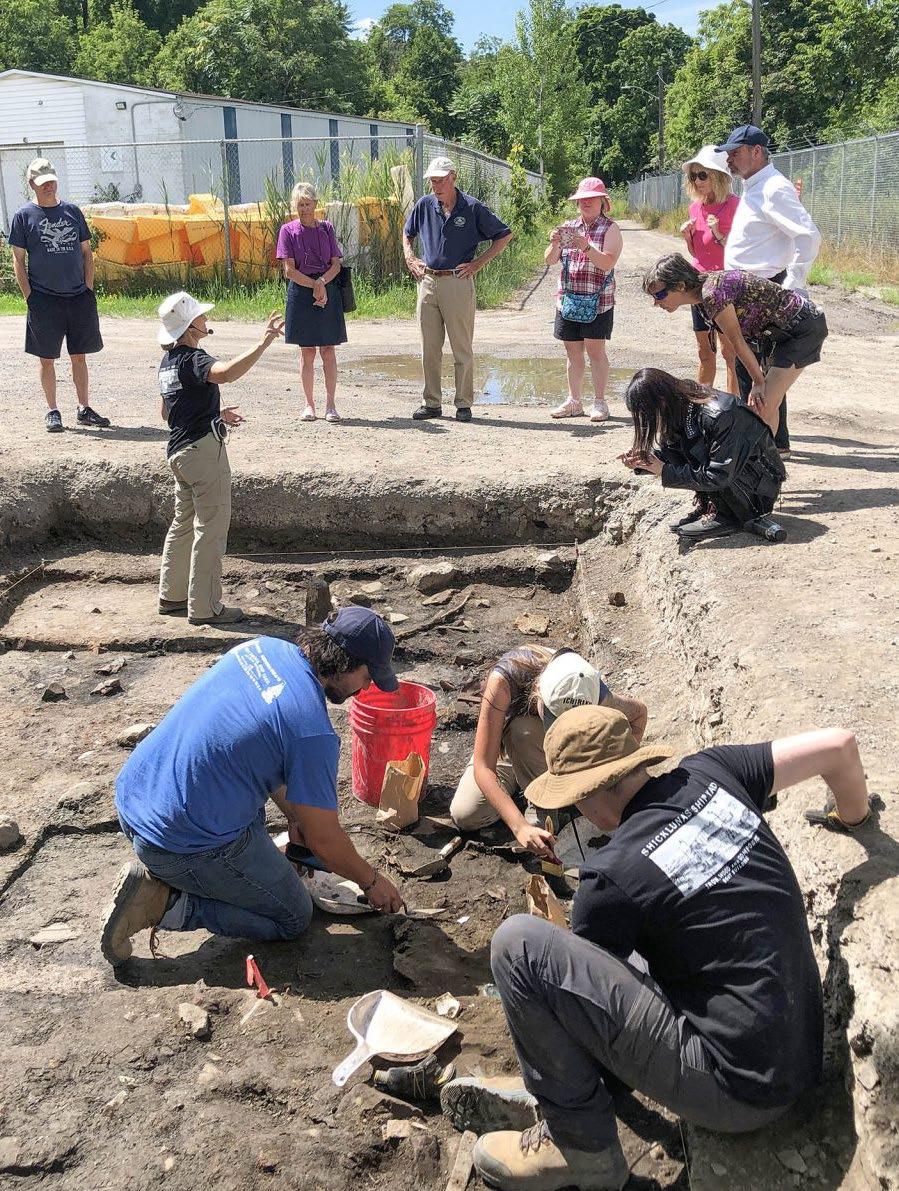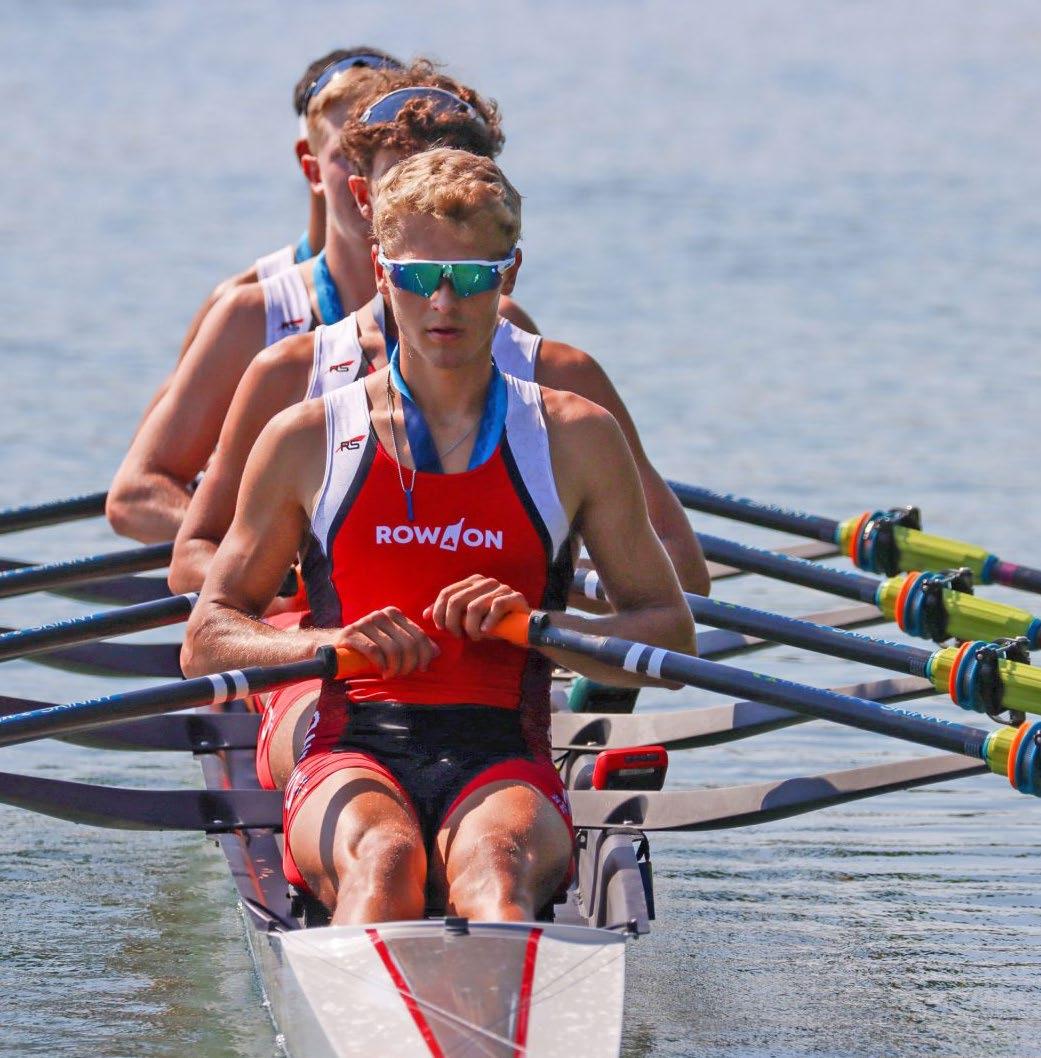Trimester 1 Report
May 1, 2022 to August 31, 2022



















This report covers the period from May 1, 2022 to Aug. 31, 2022. The trimester one report focuses on revenue estimates given that enrolment registrations and residence occupancy is highly predictable at Aug. 31. The focus on revenue is to provide ample time to mitigate shortfalls or consider investment opportunities for surpluses over the remaining two trimesters of the fiscal year.
Prior to delving into the forecast, it is appropriate to reflect on the significant accomplishments of the University community that has brought us back to in person learning with the return of a vibrant and bustling campus. Prior to the start of the fall term, Brock was honoured to host the 28th Canada Summer Games. Brock’s presence in the community, and on the national stage was elevated as we hosted over 5,000 athletes, coaches, and staff until Aug. 21. Immediately following the Canada Games, our staff pivoted to make ready our residences for a record number of students to move into their new home away from home. On Saturday, Sept. 3 and Sunday, Sept. 4, Brock’s on-campus residences welcomed more than 2,600 students for the largest Move-in Weekend in the University’s history. Brock’s hallways are full again with students beginning their in-person classes, long lines at the Starbucks and Tim Hortons on campus have returned, our parking lots are packed and this is all supported by our dedicated faculty and staff who have maintained our academic, research and community activities through transitions between virtual and in person learning.
Reviewing the results of trimester one we note that student fees are forecasted to be down vs. budget by $11.6 million or 5.7 per cent. Ancillary revenues and investment income were favourable to budget offsetting this shortfall by $1.2 million, netting an overall revenue shortfall of $10.4 million or 2.7 per cent of the total revenue budget. These results are challenging given the significant cost containment measures the University has employed over the recent years to address the 10 per cent domestic tuition rate reduction and subsequent tuition freeze, followed by the impacts of the global pandemic. The 2022-23 operating budget included a mitigation plan of $3.0 million to achieve a balanced result; therefore, this updated revenue forecast increases the mitigation target to $13.4 million as a result of not meeting our enrolment targets. While the focus of this report does not include expenses, Financial Services performed an analysis on expenses to provide some assurance on our mitigation plans developed immediately following the recognition our enrolment plan would not meet target. Taking into consideration the impact of this expense review, we believe a balanced funding result for fiscal 2022-23 remains achievable pending any significant setbacks related to the global pandemic. The greater challenge will be the development of the 2023-24 budget plan, noting enrolment shortfalls will have flow through implications into future years.
This report contains certain forward-looking information. In preparing the Trimester 1 Report, certain assumptions and estimates were necessary. They are based on information available to management at the time of preparing the forecast. Users are cautioned that actual results may vary.
Throughout the text in this report, financial values have been rounded to the nearest thousand unless otherwise stated.
Photo collage on page 3:
Students Experience: MAY 30, 2022–Brock’s Smart Start student staff are set to begin in-person delivery of the summer orientation program for the first time since 2019:
Research: JULY 12, 2022 – PhD student Jeremia Coish (left) and his supervisor, Associate Professor of Health Sciences
Adam MacNeil, recently published research showing that antibodies that fight dengue fever could potentially enhance Zika infection.
Community Engagement: JUNE 08, 2022 – Patrick Catholic Elementary School students Ella Bolan, Jack Braganza, Zoey Sibblad and Payton Foster pitched their refreshing drinks at the Goodman Lemonade event.
Inclusivity: MAY 30, 2022 – Interim Brock University President Lynn Wells, Pride Niagara Board Chair Enzo De Divitiis, and Gender and Sexual Violence Education



Co-ordinator Eve Nyambiya hold Brock’s all-inclusive flag as it’s raised to celebrate Pride Month.




The following table illustrates the trimester one revenue forecast for the University compared to budget. The information is presented on a funding basis, which represents committed cash, and based on the audited financial statements prepared in accordance with accounting standards for not for-profit organizations (NFPS). A reconciliation of the two presentations can be found on page 16

The 2022-23 trimester one forecast includes mitigation of $13.4 million for the current fiscal year. In addition to the $3.0 million mitigation target established in the 2022-23 budget, an additional $10.4 million was identified as part of the trimester one forecast as a result of a forecasted enrolment shortfall. In the past, in-year savings and underspending have allowed us to mitigate revenue challenges. We do expect certain budgeted expenditures to trend under budget, as such, we believe a balanced funding result for fiscal 2022-23 remains achievable pending any significant setbacks related to the global pandemic.

Input and recommendations for future budget decisions are encouraged and may be emailed to budgetreport@brocku.ca



As shown in Figure 2, overall revenue is forecast at $379.7 million versus the budget of $390.1 million, showing an unfavourable variance of $10.4 million, driven mainly by forecasted shortfalls in student fee revenue offset by gains in ancillary revenue and investment income. These variances will be discussed in the following sections.





As shown in Figures 3 and 4, overall enrolment is forecast to be lower than budget, with 610 less students. Proportionally the largest shortfall was seen in graduate domestic students, 19.9 per cent less than budget, followed by graduate international students 19.1 per cent less than budget, undergraduate international students down 9.4 per cent compared to budget and lastly undergraduate domestic students forecast slightly behind budget.
The lower enrolment forecast translates into overall student fee revenue showing a negative variance to budget of $11.6 million. Much of the decline versus budget is seen in international tuition, in both undergraduate ($4.7 million lower that budget) and graduate ($4.6 million lower than budget) as shown in Figure 5. This decrease is partially due to international students continuing to experience delays in receiving study permits from the Federal Government. Enrolment shortfalls are however, not only due to international challenges. Brock is currently forecasting a shortfall of $1.8 million in domestic tuition.
As shown in Figure 5, English as a Second Language (ESL) IELP and SELP program tuition revenue is forecast $0.1 million below budget. The fee revenue forecast is $0.4 million below budget driven by coop fees resulting from lower enrolment and carrythrough in certain co-op programs as well as lower than budgeted ESL ancillary fees. Note, all tuition is reported in the University Global responsibility centre except for Continuing Teacher Education, Adult Education and ESL.
1) Represents student headcount full-time (FT) and part-time (PT). For a definition refer to pg 88 of the 2022-23 Budget Report. The enrolment forecast used for the budget and forecast is 'all-in' and includes letter of permissions, non-degree students, auditors, additional qualifications, and certificates. These are excluded in the 'degree-seeking only' enrolment as presented by the Office of the Registrar.

(1) Figures based on Faculty of major.
(2) Includes letter of permission, non-degree students and auditors.
Figure 7 details grant revenue. Grant revenue is forecasted to be consistent with the budget with no known changes at the time of this report. See Appendix 2 for an analysis of the future risks associated with the government performance-based funding model.



Other revenue, as shown in Figure 8, is forecast to be $63.4 million, $1.2 million more than the budget of $62.2 million. Stronger investment income accounts for $0.7 million of this increase as well as increased ancillary revenue of $0.4 million. Investment income will be discussed in the Treasury section of this report. The forecasted increase versus budget in ancillary revenue is driven by dining revenue with an increase of $0.2 million, residence fees with an increase of $0.1 million and conference services revenue with an increase of $0.09 million. Sales and services are also forecast higher than budget by $0.1 million driven by increased Ontario University Application Centre revenue.




Figure 9 on the following page details the funding by responsibility centre by grouping the forecast and budget into one of the following categories: Teaching Faculties, Academic Support, Student Specific, Shared Services, Ancillary, Space and Global. As part of the trimester one forecast, the units with significant revenue sources were asked to update their revenue projections. Therefore, only the budgeted and forecasted revenue by responsibility centre is included in this figure. Please note that Figure 9 includes certain reclassifications to the 2022-23 budget as compared to the figures presented in the 2022-23 Budget Report. All reclassifications will be fully reconciled in the future 2023-24 Budget Report, noting the changes did not impact the net reported budget.

Government of Canada ten-year bond yield was 3.1 per cent at Aug. 31, 2022 (1.2 per cent at the same time last year). Salient to the ten-year rate is that the twoyear yield was higher at 3.64 per cent at the end of August highlighting an inverted yield curve. This trend bodes well for short-term investments where we have seen a significant increase in guaranteed investment certificate (GIC) and deposit interest rates. The yield on the operating investment portfolio is currently 3.1 per cent with an average duration of less than 1 year (1.08 per cent yield and less than 1-year average duration at the same time last year). Scotiabank prime rate was 4.70 per cent on Aug. 31, 2022 (2.45 per cent at the same time last year). Yield on cash balances and shortterm investments is linked to the prime rate, prime minus 165 basis points on cash, and prime minus 150 basis points on the 30 day hold investment account. The guaranteed investment certificate ladder (1) strategy was on hold recently with any maturing GICs being held in the 30—day hold account due to this account offering a higher rate than any GIC out to 5 years in duration. With the recent improvement in short-term GIC rates, we have increased our allocation to the GIC ladder(1) which has improved overall yield and has
resulted in stronger than budgeted returns. As a result of the higher interest rates and increased investments in GICs, our operating investment income is on track to exceed budget by $0.7 million. A summary of investment holdings as of Aug. 31, 2022 is shown in Figure 13. Figure 11 outlines monthly investment income performance compared to 2021-22. As detailed in Figure 10, operating investments have achieved 55 per cent of budget as we reach 33 per cent of the way through the fiscal year. The sinking fund has experienced significant volatility with the recent moves in equity prices and interest rates. During the first four months of fiscal 2022-23 the sinking fund posted an annualized 8.5 per cent loss (21.9 per cent gain at the same time last year). Short-term volatility is common and expected with this fund. We continue to support this fund as a long-term investment strategy to fund the 2045/2060 payout of the University's two debentures and the employee future benefits reserve. The fund requires a 5 per cent annual rate of return for the series A $93 million debenture and a 5.2 per cent rate of return for the series B $125 million debenture to achieve its goal and this rate of return is aligned with the asset mix and skill of the fund manager.
JUNE 29, 2022: Brock University and MTechHub signed a Memorandum of Understanding that will see the two organizations work together to strengthen the Canadian manufacturing industry. Pictured from left are Burlington Mayor Marianne Meed Ward, MTechHub Executive Director Mark Corker, Interim President and Vice-Chancellor of Brock University Lynn Wells and Brock’s Associate VicePresident, Professional and Continuing Studies April-Dawn Blackwell.

Future debt maturities are noted in Figure 14. Brock secured additional debt financing of $15.5 million on June 27, 2022 to fund the acquisition of 3401 Schmon Parkway from Enbridge Inc. The loan includes a fixed interest rate of 3.91 per cent through an interest rate swap agreement, locked in for 5 years, amortizing over a fifteen-year period. The acquired property is 8.16 acres of land, with an 86,591 sq. ft. commercial building on the site. The strategic acquisition was made to address the growing space requirements
of the University with usage being determined through a renewed space master planning process underway. Brock also repaid the remaining $20.6 million balance outstanding on the loan for the Roy and Lois Cairns Health and Bioscience Research Complex which matured on July 4, 2022. The debt forecast is within financial metric ranges of the University’s current credit rating; however, total debt outstanding is approaching the upper limits of the A rating. DBRS Morningstar currently rates Brock’s credit rating at A (high) with Stable trends.
(1) Fiscal full-time enrolment (FFTE). For a definition, refer to page 88 of the 2022-23 Budget Report. Note: Forecasted FFTEs have not been updated from the 2022-23 Fiscal Framework.










 JULY 19, 2022: Tim Kenyon, Brock University’s VicePresident, Research, has been appointed to a second term, effective Jan. 1, 2023.
JULY 19, 2022: Tim Kenyon, Brock University’s VicePresident, Research, has been appointed to a second term, effective Jan. 1, 2023.
The actuarial valuation on the pension plan completed as at January 1, 2020, indicated the plan was 98 per cent funded on a going-concern basis (96 per cent as at July 2017 valuation) and 106 per cent on a solvency basis (105 per cent as at July 2017 valuation). The going concern deficit improved mainly due to strong investment returns, offset by new legislation to fund a provision for adverse deviation (Pfad) which is a requirement for all single employer sponsored pension plans. The actuary sets the expected rates of returns based on industry best practices guided by the Canadian Institute of Actuaries. The University has no control or influence over these assumptions used by the actuary. The going concern deficit of $12.7 million ($17.9 million as at July 2017 valuation) has required special payments into the plan of $1.46 million and current service cost payments for the plan of $14.53 million for a total cost to the University of $15.99 million annually. Employees also contribute to the money purchase component of the plan (defined contribution) an additional $7.99 million resulting in an employer to employee funding ratio of 2.0 to 1.0.
Mercer is currently updating the full valuation as at July 1, 2022. The valuation will be brought forward for approval in December. The updated valuation will
result in changes to the special payments required to fund the plan dependent on the change to the funded status of the plan as determined by the valuation.



The investment returns and investment balance for the last eight years are detailed in Figure 17. Additional information on the pension plan may be found at brocku.ca/about/university-financials/#auditedp ension-statements

University infrastructure investment is ongoing as we invest in new and current space and technology to support and improve the student, academic and research experience. Figure 18 illustrates the number of open capital and related projects. These projects include all 2022-23 projects as well as uncompleted
prior year projects. Note: the majority of the 2022-23 projects were opened prior to May 1, 2022. Figure 19 illustrates the activity to Aug. 31, 2022 with respect to the type and dollar amount of projects. The established 2022-23 capital and related projects budget is $14.82 million (Information Technology Services Projects – $5.33 million; Facilities Management Projects – $9.49 million).
* AODA – Accessibility for Ontarians with Disabilities.
(1) Funding revenue represents total expected funding and cash received. This amount is not reflective of all funding received to date.



Throughout this report financial information has been reported on a funding basis (sometimes referred to as committed cash basis). Figures 20 and 21 detail the entries and reclassifications required to convert the funding budget to be in accordance with the Canadian accounting standards for not-for-profit organizations (NFPS). Please refer to page 90 and 91 of the 2022-23 Budget Report for detailed
explanations of all the adjustments, reclassifications and eliminations. These adjustments, reclassifications and eliminations for the 2022-23 forecast were consistently applied with those of the 2022-23 budget. The forecast for NFPS adjustment #4 has been updated and in addition the NFPS forecast also includes anticipated spending in the strategic initiative fund which is not recorded on a funding basis. It is interesting to note that Brock is the only DBRS rated University that fully reconciles and converts budget to NFPS.
Figure 22 outlines internally restricted reserve balances that have been established for strategic priorities. As at Aug. 31, 2022, Brock has $39.9 million in unspent research, professional development and strategic fund support dollars for faculty and other units including the President, Provost and Vice-President, Academic, Vice-President, Research, Vice-President, Administration and Faculty Deans. This amount compares to $33.0 million available in the same accounts at this time last year.

(1) Allocated through the revenue and expense allocation model.





 AUGUST 15, 2022: Lesley Rigg joins Brock University as its next President and ViceChancellor on Nov. 1, 2022.
AUGUST 15, 2022: Lesley Rigg joins Brock University as its next President and ViceChancellor on Nov. 1, 2022.


AUGUST 22, 2022: Brock’s Centre for Bone and Muscle Health marks 10 years of research, and community impact. In this 2017 file photo, Edwin Avila, a PhD candidate who was visiting Brock University from the Italian Institute of Technology, demonstrates the ‘wristbot,’ a robot used to examine how the forearm muscles control the hand. This unique equipment is in a lab of the Centre for Bone and Muscle Health. Taking readings in the background is Kinesiology master’s student Garrick Forman.

While there is no forecasted change to the grant budget, this analysis is provided to highlight future risks associated with the governments performancebased funding model intended to take effect in 2023-24. Figures 24 and 25 were provided by the Ministry of Colleges and Universities (MCU) after the 2021-22 fiscal year-end to inform the University sector of our imputed impact of the new performance-based funding model that was intended to be operational for the Strategic Mandate Agreement 2020-25 (SMA3). Due to the global pandemic the Province announced that performance-based funding would be delayed and will remain as such until the end of the current fiscal year. Starting in 2023-24 the Province has signaled that performance-based funding will commence. The Province also noted that they would remain flexible to have conversations with institutions who do not meet their performance metric targets with the potential to avoid immediate funding cuts; however, the framework for these conversations has not yet been established. The 2021-22 results of
performance-based funding provided by the Province in Figure 24 outlines Brock exceeded our targets in 8 out of 10 areas, which is a significant achievement. However, the funding model would have seen an $0.87 million reduction in operating grant funding due to missing two of our targets, economic impact and experiential learning. The funding formula does not provide any upside to grant allocations for exceeding expectations, only a reduction if any of the 10 metrics do not fully achieve target. While performance-based funding remains paused for 2022-23, Figure 25 forecasts our performance metrics for the current year which suggests we will exceed our targets on both economic impact and experiential learning; however, a slight shortfall is estimated in graduate employment rate in a related field and community/local impact of student enrolment. The imputed grant reduction is $0.07 million based on this current estimate. This reduction is not included in the Trimester 1 revenue forecast since the Province has established this model remains on pause. Beyond fiscal 2022-23 performance-based funding will add potential negative variances to our previously fixed level of grant funding from the Province.
(1) Actual Achieved Allocation is calculated by multiplying the Notional Allocation by Target Achievement, to a maximum of 100%. Universities that have Target Achievement of 100% or higher are eligible for reallocated funding from universities that underachieve their targets on that metric that year.
(1) Actual Achieved Allocation is calculated by multiplying the Notional Allocation by Target Achievement, to a maximum of 100%. Universities that have Target Achievement of 100% or higher are eligible for reallocated funding from universities that underachieve their targets on that metric that year.



AUGUST 24, 2022: Kait Kribs, Brock LINC Digital Research and Communications Officer. discusses upcoming research opportunities for the new Digital Collaboratory.


 AUGUST 26, 2022: Brock University welcomed a large contingent of international educational recruitment partners to learn about and tour campus.
AUGUST 26, 2022: Brock University welcomed a large contingent of international educational recruitment partners to learn about and tour campus.












